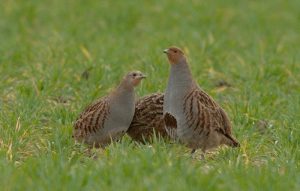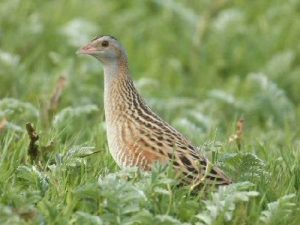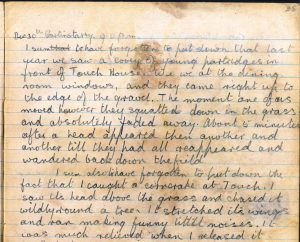At the end of another year, Viola is reflecting on her diary entries and makes a note of two things she had seen in 1921 that she neglected to put into it earlier in the year. Both comments relate to experiences with birds that blend into their landscapes.
The first refers to a group of young partridges that she spotted in the grounds of Touch House. This is likely to have been the Grey Partridge as it is more commonly found in Scotland.
Often regarded as a game bird, the grey partridge has a distinctive orange face and flies with a characteristic whirring noise. It is a ground bird and is seen across the UK. It has excellent camouflage for the habitats that it usually frequents. Viola correctly uses the collective noun for a group of partridges, which is a covey. You can read more about the grey partridge here.
Similarly camouflaged, the corncrake was once very common in Scotland but is now in decline owing to a reduction in suitable habitat. Viola describes running ‘wildly round a tree’ to catch one, which must have been quite a feat as they are very secretive and spend much of their time hiding in long grass and vegetation where their feather patterns render them almost invisible. It is more likely that you would hear a corncrake rather than to see one as they have a very distinctive rasping call, hence the name.
Their Latin name is ‘crex crex’, which also relates to the sound that they make when calling. This sound, once familiar in the Scottish countryside, has now become a rarity because of human encroachment into the areas that the birds previously made their home. You can read more about the corncrake here.
Dec 30th Gartinstarry. 9.00 p.m.
I seem to have forgotten to put down that last
year we saw a covey of young partridges in
front of Touch House. We were at the dining
room windows, and they came right up to
the edge of the gravel. The moment one of us
moved however they squatted down in the grass
and absolutely faded away. About 5 minutes
after a head appeared then another and
another till they had all reappeared and
wandered back down the field.
I seem also to have forgotten to put down the
fact that I caught a corncrake at Touch. I
saw its head above the grass and chased it
wildly round a tree. It stretched its wings
and ran making funny little noises. It
was much relieved when I released it.


